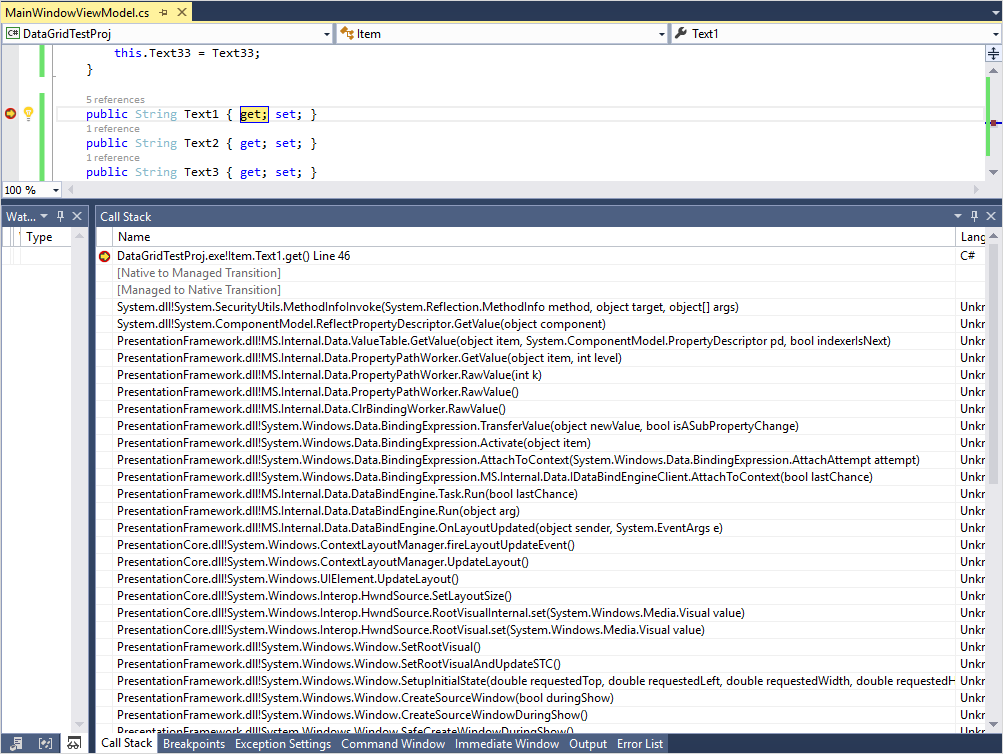WPF DataGrid의 데이터 바인딩 시 리플렉션의 부하는 어느 정도일까요?
최근에 아래와 같은 질문이 있었는데요.
컬럼이 많은 데이터그리드에서 정렬 할 때 속도가 느립니다.
; https://www.sysnet.pe.kr/3/0/3608
; https://www.sysnet.pe.kr/3/0/3609
; https://www.sysnet.pe.kr/3/0/3610
WPF의 경우 DataGrid에 바인딩된 요소를 접근하는 과정에 리플렉션을 사용하게 됩니다. (범용적인 데이터 바인딩이니 이는 어쩔 수 없는 부분입니다.) 이를 확인하는 방법은 해당 속성을 접근하는 get 코드에 BP를 걸고 Call Stack을 보면 됩니다.

모든 값을 리플렉션으로 접근하는 것은 느릴 수 있을텐데, 과연 얼마나 느릴까요? ^^ 궁금해졌습니다.
테스트를 쉽게 하기 위해 "
컬럼이 많은 데이터그리드에서 정렬 할 때 속도가 느립니다." 글에 포함된 예제를 변형했는데요. 우선, xaml은 다음과 같이 구성하고,
<Window x:Class="DataGridTestProj.MainWindow"
xmlns="http://schemas.microsoft.com/winfx/2006/xaml/presentation"
xmlns:x="http://schemas.microsoft.com/winfx/2006/xaml"
xmlns:local="clr-namespace:DataGridTestProj"
Title="MainWindow" Height="350" Width="525">
<Grid>
<Grid.RowDefinitions>
<RowDefinition Height="50" />
<RowDefinition Height="*" />
</Grid.RowDefinitions>
<Button Grid.Row="0" Click="Button_Click" />
<DataGrid x:Name="dg" Grid.Row="1" AutoGenerateColumns="False" IsReadOnly="True"
VirtualizingPanel.IsVirtualizing="True" VirtualizingPanel.VirtualizationMode="Recycling"
EnableColumnVirtualization="True" EnableRowVirtualization="True">
<DataGrid.Columns>
<DataGridTextColumn Header="Text1" Binding="{Binding Text1}" Width="150"/>
...[2~32까지 생략]...
<DataGridTextColumn Header="Text33" Binding="{Binding Text33}" Width="150"/>
</DataGrid.Columns>
</DataGrid>
</Grid>
</Window>
xaml.cs는 Button_Click 시 정렬하는 코드와 렌더링 부하 측정 코드를 추가했습니다.
using System;
using System.Collections.Generic;
using System.Diagnostics;
using System.Windows;
using System.Windows.Threading;
namespace DataGridTestProj
{
public partial class MainWindow : Window
{
List<Item> list;
bool reverse = false;
public MainWindow()
{
InitializeComponent();
list = MakeList();
dg.ItemsSource = list;
}
private void Button_Click(object sender, RoutedEventArgs e)
{
reverse = !reverse;
dg.ItemsSource = null;
list.Sort((e1, e2) => e1.Text1.CompareTo(e2.Text1) * ((reverse == true) ? 1 : -1));
dg.ItemsSource = list;
Stopwatch st = new Stopwatch();
st.Start();
Dispatcher.BeginInvoke(DispatcherPriority.Loaded, new Action<object>(CheckTime), st);
}
private void CheckTime(object value)
{
Stopwatch st = value as Stopwatch;
st.Stop();
System.Diagnostics.Trace.WriteLine("DataGrid.RenderTime: " + st.ElapsedMilliseconds);
}
public List<Item> MakeList()
{
Random rnd = new Random();
List<Item> list = new List<Item>();
for (int i = 0; i < 1133; i++)
{
list.Add(
new Item(
rnd.Next(1, 13232323).ToString(),
// ...[생략]...
rnd.Next(1, 13232323).ToString()
)
);
}
return list;
}
}
}
public class Item
{
public Item(String Text1 = "",
//...[생략]...
String Text33 = "")
{
this.Text1 = Text1;
//...[생략]...
this.Text33 = Text33;
}
public String Text1 { get; set; }
//...[생략]...
public String Text33 { get; set; }
}
이렇게 하고 윈도우를 최대화시켜 테스트 해보면, 제 컴퓨터에서 Button을 누를 때 마다 Output 창에 다음과 같은 결과를 볼 수 있었습니다.
DataGrid.RenderTime: 365
DataGrid.RenderTime: 356
DataGrid.RenderTime: 365
DataGrid.RenderTime: 369
DataGrid.RenderTime: 340
이제 같은 예제를 리플렉션이 아닌 strong 타입으로 접근하도록 바꿔야 하는데요. 이것이 가능하려면 DataGrid의 Columns에 정의된 DataGridTextColumn을 사용자 정의 타입으로 바꿔야 합니다.
<Window x:Class="DataGridTestProj.MainWindow"
xmlns:local="clr-namespace:DataGridTestProj"
...[생략]...>
<Grid>
...[생략]...
<DataGrid x:Name="dg" ...[생략]...>
<DataGrid.Columns>
<local:myDataGridTextColumn Header="Text1" Field="Text1" Width="150"/>
...[생략]...
<local:myDataGridTextColumn Header="Text33" Field="Text33" Width="150"/>
</DataGrid.Columns>
</DataGrid>
</Grid>
</Window>
당연히 myDataGridTextColumn 클래스를 구현해야겠지요. ^^
public class myDataGridTextColumn : DataGridTextColumn
{
public static readonly DependencyProperty FieldProperty =
DependencyProperty.Register("Field", typeof(string),
typeof(myDataGridTextColumn), new FrameworkPropertyMetadata(null));
public string Field
{
get { return (string)GetValue(FieldProperty); }
set { SetValue(FieldProperty, value); }
}
protected override FrameworkElement GenerateElement(DataGridCell cell, object dataItem)
{
FrameworkElement fe = base.GenerateElement(cell, dataItem);
TextBlock tb = fe as TextBlock;
string fieldValue = null;
Item item = (dataItem as Item);
switch (Field)
{
case "Text1":
fieldValue = item.Text1;
break;
// ...[case 문 생략]....
case "Text33":
fieldValue = item.Text33;
break;
}
tb.Text = fieldValue;
return fe;
}
}
GenerateElement 메서드를 재정의해 object로 넘어온 Item 타입 인스턴스의 내부 필드를 리플렉션이 아닌 직접 접근하는 방식으로 바꿀 수 있습니다. 이렇게 하고 실행했더니... Button을 누를 때마다 다음과 같은 결과를 보였습니다.
DataGrid.RenderTime: 339
DataGrid.RenderTime: 310
DataGrid.RenderTime: 332
DataGrid.RenderTime: 309
DataGrid.RenderTime: 316
350ms 대에서 310ms 수준으로 떨어졌는데 미세하게 빨라졌다는 느낌을 받게 됩니다. 그렇지만, 예상과는 달리 리플렉션이 과히 무거운 수준은 아님을 알 수 있습니다. 사실, 리플렉션을 사용해도
MethodInfo에 대한 cache나 LCG(Lightweight Code Generator)같은 것을 곁들이면 일반 메서드 호출과 거의 차이가 없기 때문에 마이크로소프트에서 최적화를 잘 했던 것으로 보입니다.
그럼 과연, 어디서 렌더링 타임이 잡아먹는 걸까요?
이런 경우, 의심할만한 요소라면 MeasureOverride, LayoutOverride 정도가 될 것입니다. 이를 확인하기 위해 DataGrid 내의 VirtualizingStackPanel을 교체해 볼 수 있습니다.
<DataGrid x:Name="itemGridView" Grid.Row="1" ItemsSource="{Binding list}" AutoGenerateColumns="False"
VirtualizingPanel.IsVirtualizing="True"
VirtualizingPanel.VirtualizationMode="Recycling"
>
<DataGrid.ItemsPanel>
<ItemsPanelTemplate>
<local:myVirtualizingStackPanel />
</ItemsPanelTemplate>
</DataGrid.ItemsPanel>
...[생략]...
</DataGrid>
public class myVirtualizingStackPanel : VirtualizingStackPanel
{
protected override Size MeasureOverride(Size availableSize)
{
Stopwatch st = new Stopwatch();
st.Start();
Size size = base.MeasureOverride(availableSize);
st.Stop();
System.Diagnostics.Trace.WriteLine("myVirtualizingStackPanel.MeasureOverride: " + st.ElapsedMilliseconds);
return size;
}
protected override Size ArrangeOverride(Size arrangeBounds)
{
Stopwatch st = new Stopwatch();
st.Start();
Size size = base.ArrangeOverride(arrangeBounds);
st.Stop();
System.Diagnostics.Trace.WriteLine("myVirtualizingStackPanel.ArrangeOverride: " + st.ElapsedMilliseconds);
return size;
}
}
이렇게 교체하고 실행한 결과는 다음과 같습니다.
myVirtualizingStackPanel.MeasureOverride: 427
myVirtualizingStackPanel.ArrangeOverride: 164
DataGrid.RenderTime: 660
427 + 164 == 591이니까 DataGrid의 전체 렌더링 시간의 주요 부하로 보입니다. 그런데, 이상하군요. 왜 300 수준에서 600 수준으로 늘어난 것일까요? 그것은 DataGrid 스스로 내부 VirtualizingStackPanel을 사용하면서 EnableColumnVirtualization, EnableRowVirtualization 속성을 통해 Column과 Row에까지 가상화를 하는 최적화를 수행하지만, 사용자가 설정한 VirtualizingStackPanel에는 이 역할을 수행하지 않기 때문입니다. 즉, 이전에는 나름대로의 최적화를 좀 더 수행할 수 있었던 것입니다. (참고로, 사용자 정의 VirtualizingStackPanel을 지정한 상태에서 EnableColumnVirtualization, EnableRowVirtualization 속성을 True로 설정하면 UI가 엉망으로 나옵니다. 이거 정상으로 나오게 하는 방법이 있을까요? ^^)
결론을 내리면, 행/열이 많은 DataGrid의 렌더링을 최적화하려면 내부 StackPanel에 대한 MeasureOverride, ArrangeOverride를 개선한 사용자 정의 패널을 만들어야 합니다. 가령, 행/열의 변화가 없다면 별도로 Measure/Arrange 작업을 할 필요없이 곧바로 현재 보유중인 FrameworkElement의 텍스트만 교체하는 코드가 동작하도록 해야겠지요. 아마 작업이 쉽진 않을 것입니다.
DataGrid를 꼭 써야 하는 것이 아니라면, 이런 경우 차라리 ListView를 선택하는 것이 더 좋은 방법일 수 있습니다.
<ListView Name="dg" Grid.Row="1" VirtualizingPanel.IsVirtualizing="True" VirtualizingPanel.VirtualizationMode="Recycling">
<ListView.View>
<GridView>
<GridViewColumn Header="Text1" DisplayMemberBinding="{Binding Text1}" Width="150"/>
...[생략]...
</GridView>
</ListView.View>
</ListView>
그럼, 리플렉션을 이용한 속성 접근임에도 불구하고 280대로 렌더링 시간이 내려가서 체감상 거의 느리다는 느낌이 들지 않습니다.
ListView.RenderTime: 286
ListView.RenderTime: 290
ListView.RenderTime: 287
ListView.RenderTime: 296
ListView.RenderTime: 284
물론, DataGrid에서 기본 제공하는 header를 눌러 정렬하는 기능이 제공되지 않지만 이것은 다음의 글을 보고 구현해 주면 됩니다.
How-to: ListView with column sorting
; http://www.wpf-tutorial.com/listview-control/listview-how-to-column-sorting/
(
첨부한 파일은 위의 예제 코드를 포함합니다.)
[이 글에 대해서 여러분들과 의견을 공유하고 싶습니다. 틀리거나 미흡한 부분 또는 의문 사항이 있으시면 언제든 댓글 남겨주십시오.]